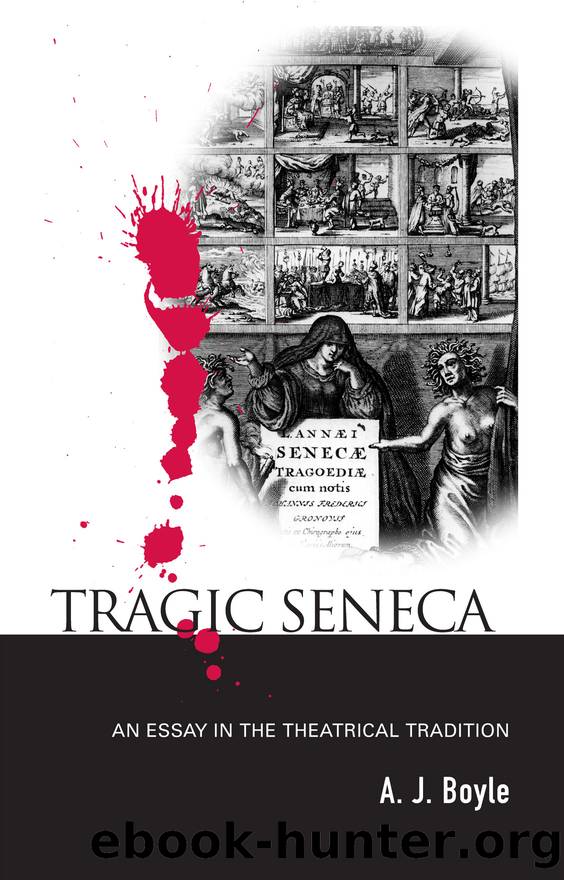Tragic Seneca by Boyle A. J

Author:Boyle, A. J. [A. J. Boyle]
Language: eng
Format: epub
ISBN: 9781134802302
Publisher: Taylor & Francis (CAM)
An event is either staged or reported.
The mind is stirred less vividly through the ear
Than by what's cast before reliable eyes and which
The audience sees for itself. But don't produce on stage
What should be performed behind the scenes, and keep
From sight much which will soon be eloquently told.
Don't let Medea butcher her children in public,
Nor monstrous Atreus cook human flesh on stage,
Nor Procne turn into a bird, and Cadmus a snake.
All such displays I disbelieve and loathe.
Seneca's Medea breaks these prescriptions, and stages not only the filicide but the shedding of Medea's own blood during the Black Mass. Perhaps Thyestes is also in breach, for, although a messenger narrates the cooking of the children's flesh, their severed heads are displayed in the final act Neither Oedipus nor Phaedra would have met with Horace's approval, since Jocasta commits sexual suicide at the end of the former, as does Phaedra at the end of the latter, where the final act is particularly bloody as Theseus tries to assemble Hippolytus' corpse. The incomplete Phoenissae too probably would have climaxed in a scene of sexual suicide.36 The other three plays exhibit either no violent deaths on stage, or possibly one, if Hercules has not already left the stage when he slays the first child at Hercules Furens 992ff,37 Such violence and bloodshed could have been Vividly' represented through the use of artificial blood-bags, attested for the Roman stage from the time of Caligula.38 Much violence too is narrated in Senecan tragedy in accordance with the purest of Hellenic modes and standard Roman republican practice. In all but Medea and Phoenissae the narration of such violence is extensive. The bloody deaths of Agamemnon, of Hercules' wife and children, of Astyanax and Polyxena, of Thyestes' children, of Hippolytus, Oedipus' act of self-blinding, are conveyed to the audience aurally (per aurem, Ars Poetica 180) by messengers or eye-witnesses (in Cassandra's case a clairvoyant one). In these narrations there is a focus on the body, its inner and outer parts, their penetration and dismemberment, entirely in accord with Roman dramatic practice from its inception and with Roman poetic practice from Ovid.39
quos enim praeceps locus
reliquit artus? ossa disiecta et graui
elisa casu. signa clari corporis
et ora et illas nobiles patris notas
confudit imam pondus ad terram datum,
soluta ceruix silicis impulsu; caput
ruptum cerebro penitus expresso. iacet
deforme corpus.
(Troades 110—17)
Download
This site does not store any files on its server. We only index and link to content provided by other sites. Please contact the content providers to delete copyright contents if any and email us, we'll remove relevant links or contents immediately.
Call Me by Your Name by André Aciman(20427)
Ready Player One by Cline Ernest(14572)
How to Be a Bawse: A Guide to Conquering Life by Lilly Singh(7426)
Wiseguy by Nicholas Pileggi(5704)
The Kite Runner by Khaled Hosseini(5128)
On Writing A Memoir of the Craft by Stephen King(4889)
Audition by Ryu Murakami(4886)
The Crown by Robert Lacey(4759)
Call me by your name by Andre Aciman(4645)
Gerald's Game by Stephen King(4607)
Harry Potter and the Cursed Child: The Journey by Harry Potter Theatrical Productions(4465)
Dialogue by Robert McKee(4352)
The Perils of Being Moderately Famous by Soha Ali Khan(4189)
Dynamic Alignment Through Imagery by Eric Franklin(4170)
Apollo 8 by Jeffrey Kluger(3664)
Seriously... I'm Kidding by Ellen DeGeneres(3601)
The Inner Game of Tennis by W. Timothy Gallwey(3598)
How to be Champion: My Autobiography by Sarah Millican(3569)
Darker by E L James(3492)
